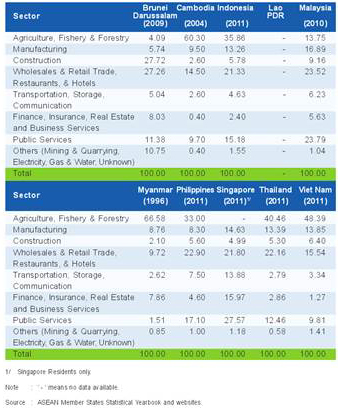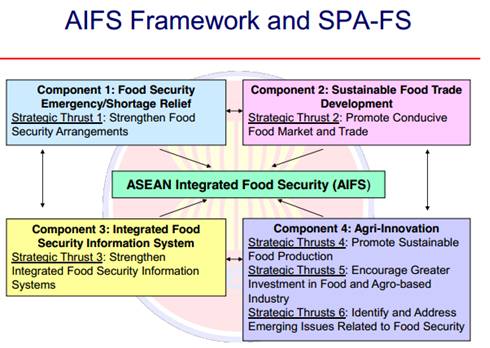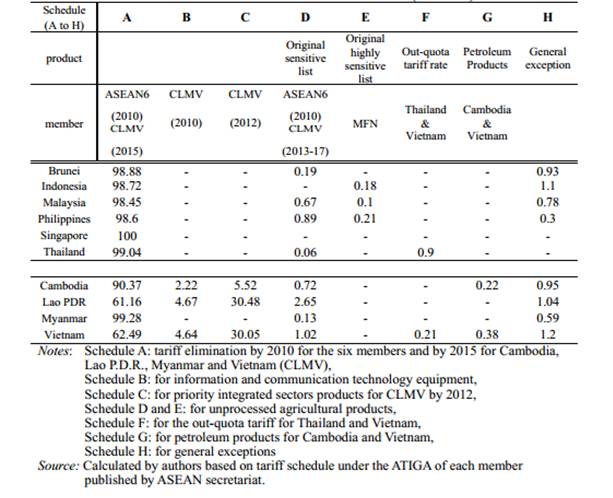Module 15: ASEAN Food Production and Supply
Table of Contents
Reading Text & Presentation
15.1 The ASEAN food business
 The food and agricultural sectors are top priorities for ASEAN countries considering their economic, social and environmental importance. ASEAN Community building is concerned with its contribution to food security, poverty alleviation, rural development, and trade.
The food and agricultural sectors are top priorities for ASEAN countries considering their economic, social and environmental importance. ASEAN Community building is concerned with its contribution to food security, poverty alleviation, rural development, and trade.
ASEAN member states employment by sector in per cent for the periods indicated
15.1.1 Types of ASEAN food business
Food businesses in ASEAN can be categorized as follows:
1. Primary producers At the primary production stage, food businesses produce raw food for human consumption such as rice farms, fish farms, fruit and vegetable farms, poultry farms, dairy and beef cattle farms and bee-keepers. |
2. Manufacturer/ processors At the secondary production stage, food businesses participate in food manufacturing/ processing and/or food packaging, such as the milk industry, canning industry, bakery industry, jam and jelly manufacturers. Food processors that convert the primary foods to flour can also be grouped in this category. |
3. Distributors , transporters and wholesalers This phase includes pre-retail distribution activities, particularly importation, wholesaling, wholesale storage, and multi-purpose wholesalers who distribute not only to retailers but also to restaurant owners or consumers. |
4. Retailers This stage involves all food retail activities that sell the food to the final consumer such as supermarkets and market stalls usually found in traditional markets. |
5. Service Sector This category includes all forms of catering, including take-away food stalls and catering facilities in firms, school canteens, restaurants and public institutions. |
6. Customers At this phase, goods are sold to the final consumer directly, often by retailers such as bakers, ice cream manufacturers and on-farm manufacturers such as brown sugar processors. |
15.1.2 ASEAN Integrated Food Security (AIFS)

< AIF Framework and SPA-FS
The ASEAN Integrated Food Security (AIFS) Frameworks, adopted by ASEAN leaders at the 14th ASEAN Summit in 2009, consists of a five-year action plan for ASEAN member states. Its purpose is to integrate efforts in strengthening food security and to stabilize highly fluctuating food prices in the region. This Framework promotes food security and development of sustainable food production through improvements in agricultural infrastructure which are;
- minimizing post-harvest losses;
- reducing transaction costs;
- maximizing agricultural resources;
- promoting agricultural innovation through research and development; and
- increasing agricultural productivity, accelerating transfer, and adoption of new technologies.
15.1.3 ASEAN Free Trade Area (AFTA)
Food production in ASEAN is export-oriented. When the non-tariff barriers are eliminated under AFTA, the establishment of the ASEAN Economic Community (AEC) will lead to a real free trade and investment area within 15 years. Although trading across the region is becoming more aggressive, this provides new opportunities for larger sub-regional and national food businesses to develop regional marketing strategies, and target more than just their home food markets with their branded products. Consequently, there are more local businesses operating within ASEAN's borders stepping into stronger regional multinationals that are able to compete more effectively in the international markets.
Four areas in which the ASEAN community would bring the greatest benefits to the ASEAN food business:
- nutrition labeling;
- pre-market product registration;
- import/export certification of food ingredients, additives and flavors; and
- contaminant limits and analytical methods.
After the ASEAN food business foundation changed during 1997 to 1988, the inflow of new investment entered the food manufacturing industry and distribution channels across the region. ASEAN states benefit from manufactured products that qualify for export under AFTA. The strategies taken by individual food manufacturers open up new markets for the full range of food and drinks. Markets over a period of years have competed with more efficient and dynamic competitors in the food supply chain, especially the major retailers and distributors who have more choice to import ASEAN-content products.

Tariff Elimination Schedule for the ASEAN Trade in Goods Agreement (ATIGA) in 2010 (Unit: %)
Language Focus 15.1
Language Focus 1Language Focus 2
Activities
Activity 1Activity 2Activity 3Activity 4Activity 5